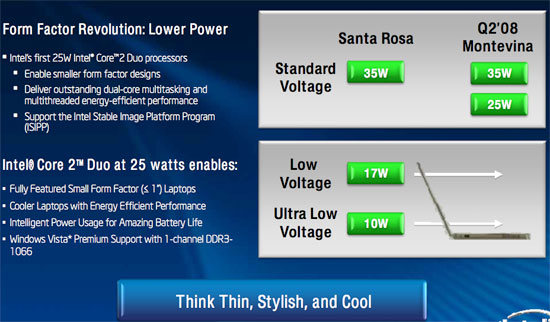A Preview of Intel's Centrino 2 Platform
by Anand Lal Shimpi on July 15, 2008 12:00 AM EST- Posted in
- Laptops
The Lowest Power Core 2 Centrino, Ever
The table below can get a little confusing but it's paramount to understanding the power benefits of Centrino 2:
| Core 2 Duo (45nm Penryn) | Core 2 Duo (45nm Penryn) | Core 2 Duo (65nm Merom) | Core 2 Duo (65nm Merom) | |
| Platform | Montevina | Santa Rosa Refresh | Santa Rosa | Napa |
| TDP | 25W | 35W | 35W | 34W |
| Vcc (High Frequency Mode) | 0.9V - 1.25V | 1.0V - 1.25V | 1.0375V - 1.3V | 1.0375V - 1.3V |
| Vcc (Low Frequency Mode) | 0.85V - 1.025V | 0.85V - 1.025V | 0.85V - 1.05V | 0.75V - 0.95V |
| Vcc (Super LFM) | 0.75V - 0.95V | 0.75V - 0.95V | 0.75V - 0.95V | N/A |
| Icc @ 2.4GHz HFM | 38A | 44A | 41A | 41A |
The far right column has the first Core 2 Centrino platform, codenamed Napa and to its left we have the beloved Santa Rosa platform. You'll notice that the voltage and current characteristics of these two CPUs are virtually identical, which makes sense since they are both based on the 65nm Merom. The first Penryn parts appeared in the next column over with the Santa Rosa Refresh. Note that here, while the voltages dropped vs. Merom, maximum current draw actually went up to 44A from 41A. This could be due to greater leakage, the higher clock speeds offered by Penryn or simple inexperience with the 45nm process compared to Intel's tried-and-true 65nm process upon its release.

The three platforms we just mentioned however all carry a 34/35W TDP, but now at 2.4GHz with Montevina Intel has lowered the TDP by 10W to 25W. The lower TDP is made possible by dropping voltages a bit further, note that in its highest frequency mode the minimum Vcc has been lowered to 0.9V down from 1.0V. The end result is both lower voltages and lower maximum current draw than any previous Core 2 based Centrino platform.










12 Comments
View All Comments
Penryn123 - Tuesday, July 15, 2008 - link
Will new 25W CPUs also work in Santa Rosa boards? (drop-in replacement possible?)Visual - Tuesday, July 15, 2008 - link
Shame on Intel for the crappy launch... and the whole lot of hype and noise about the "new platform" seems out of place to me, seeing as it is simply more of the same old.The new integrated GPU is really the only big change to me, but I already have very low expectations for it. Nothing unusual, we're already used to Intel's GPUs being inferior to nVidia/ATI. Shame that the "platform" requires an Intel chipset.
The dynamic switching between discrete and integrated GPU has potential, but then again it may be completely useless if the discrete GPUs are able to tune down their power drain when used only for 2D or Aero.
I'm not too excited about detailed specs or performance numbers of the platform itself - "it's good enough" and "it's better than the old one" is all most people need to know and understand really.
I am much more interested in knowing what new things the OEMs are cooking. Will we finally get some decent GPU in a tablet, will we get multi-touch screens, will we get something like AMD's idea of 16x pci-express connector for external GPUs, etc... all things that are quite unrelated to Intel and the new platform launch - they have been possible all along with the old platform and I'm a bit disappointed they are still being delayed.